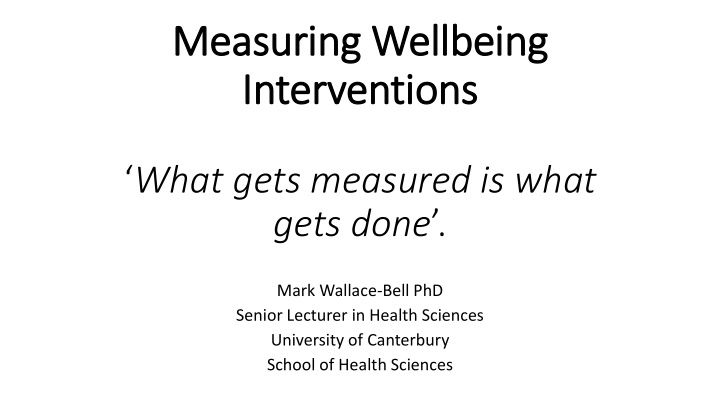



Measuring Wellbeing In Interv rventions ‘ What gets measured is what gets done ’. Mark Wallace-Bell PhD Senior Lecturer in Health Sciences University of Canterbury School of Health Sciences
Why evaluation and measurement is important • Huge growth in wellbeing and wellness interventions • Increasing investment • Need to research and evaluate interventions to inform best practice • Need for unbiased research • Controlled research and evaluation protects against bias
Determine Benchmarks • Attitudes towards wellbeing • Employee activity levels before the program is started • Employee health-various measures could be employed • Current costs of illness to benefit programs • Stress levels • Absenteeism patterns • Employee satisfaction • Retention rates • Productivity and performance • Some of these can be assessed through your HR data sources
Step Two – Measurement • After the program has been running for at least six months to a year follow-up research should be undertaken to measure the short-term results of the wellness intervention. • Repeat evaluations should be done again at the 5 and 10 year mark to determine long term effects
Process, , Im Impact and outcomes • Ideally, performance measurement enables an organization to: • Determine if a program has been implemented as planned (process measurement); • Determine if a program has met its quality assurance criteria (process measurement); • Assess if a program is attracting the volume of participants that it intended (process measurement); • Document the individual employee health impacts of a program (impact measurement); • Identify the health outcomes of a program as it relates to disability management and absenteeism rates (outcome measurement); • Determine the cost benefit of a program (outcome measurement); and • Establish whether an ongoing commitment to the program is justified.
Process Measurement Process measurements review short-term program/intervention oriented results — quality control measures aimed at determining if the program/intervention itself has achieved its objectives. These may be derived through after intervention evaluation forms. • Typical process measurements include: • Participation rates • Adherence levels (if a long-term program) • Participant satisfaction • Perceived value • Management commitment
Im Impact measurements Impact measurements review medium-term individual employee results. They identify whether or not intended individual health outcomes are occurring on a personal level. Post Employee Wellness Questionnaires may be utilized to determine these results. • Typical impact measurements may include: • Decreased Employee Health Risk usually through health-risk assessments; • Improved Health Beliefs and Attitudes through health surveys; • Improved Perceived Health Status through health surveys; • Readiness for Change through health surveys; • Improved Employee Satisfaction, as measured by a questionnaire; • Employee perception of greater personal power and control over their work environment, as measured by certain stress indicators; • Reduced incidence of new cardiovascular cases • Reduced incidence of new musculoskeletal injuries.
Outcome measurements Outcome measurements are longer term, organization-oriented results that indicate whether or not a program is generating the intended economic outcomes for the organization. • Typical outcome measures include: • Decreased incidence of illness or injury associated with stress, cardiovascular and musculoskeletal disorders; • Reduction in the length of a disability associated with stress, cardiovascular and musculoskeletal disorders; • Cost savings in health benefits such as long-term disability, short term disability, Workers’ Compensation and drug utilization associated with stress, cardiovascular and musculoskeletal disorders; and • Financial measurements, including cost/benefit analysis and Return on Investment calculations.
Data Data Data, “I liked fitness apps, and thought it was a free bit of cool kit,” “I didn’t think about it as giving up information about myself, but looking back that was quite naive.” • Who owns the data? • Who stores it? • Can it be sold? • Analysis of large data sets requires more sophisticated models
Questions to ask? • Does your company measure the success of its wellness programs? • Do you use reliable and validated tools to monitor impact? • Do you have an evaluation methodology in place? • Do you have the expertise to develop your strategy and provide quality assurance? • Is evaluation important to your decision makers? • Are you measuring ROI? • Do you have a policy on ethics and Consent for data collection
Examples of quality measurement guides • Health Enhancement Research Organization (HERO) • www.hero-health.org • Program Measurement and Evaluation Guide: Core Metrics for Employee Health Management: • Financial outcomes • Health impact • Participation • Satisfaction • Organizational support • Productivity and performance • Value on investment • Grossmeier J, Terry PE, Cipriotti A, Burtaine JE. Best practices in evaluating worksite health promotion programs. American Journal of Health Promotion. Jan/Feb 2010; 24(3):TAHP1 – TAHP9.
Recommend
More recommend